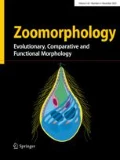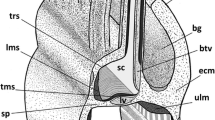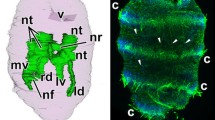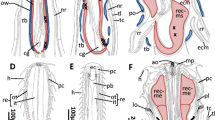Abstract
Among other characteristics a trimeric coelomic compartmentation consisting of an anterior protocoel, followed by a mesocoel and a posterior metacoel is traditionally believed to substantiate the sister-group relationship between Lophophorata and Deuterostomia, together forming the Radialia. As molecular data cannot support this hypothesis a reanalysis of the coelomic cavities in Phoronida is undertaken, because corresponding coelomic compartmentation is widely accepted to support the Radialia hypothesis. A coelomic cavity can be recognized on the ultrastructural level because its lining is a true epithelium with polarized cells interconnected by apical adherens junctions. This study reveals that neither in larval nor adult Phoronis muelleri (Phoronida) an anterior cavity with such a lining is present. What on the light microscopic level leads to the impression of a cavity inside the larval episphere, actually is an enlarged subepidermal extracellular matrix with an amorphous, presumably gel-like filling, into which several muscle cells are embedded. Larvae, thus, possess only one coelomic cavity, the large trunk coelom of the larva which is adopted in the adult organization. The second coelomic cavity of adult P. muelleri, the lophophore coelom, develops as a double-layer of epithelialized mesodermal cells at the base of the adult tentacle buds and becomes fluid filled during metamorphosis. Like the larval episphere, larval tentacles and most parts of the blastocoel are filled by an amorphous matrix. Reanalysis of the literature and comparison with Brachiopoda and Bryozoa allows the hypothesis that a protocoel is lacking in all Lophophorata, and that merely two unpaired coelomic cavities, one tentacle and one trunk coelom, can be assumed for the ground pattern of this taxon. These results do not provide further evidence for the Radialia hypothesis, but also do not contradict it.
Similar content being viewed by others
Author information
Authors and Affiliations
Additional information
Accepted: 28 August 2000
Rights and permissions
About this article
Cite this article
Bartolomaeus, T. Ultrastructure and formation of the body cavity lining in Phoronis muelleri (Phoronida, Lophophorata). Zoomorphology 120, 135–148 (2001). https://doi.org/10.1007/s004350000030
Issue Date:
DOI: https://doi.org/10.1007/s004350000030




